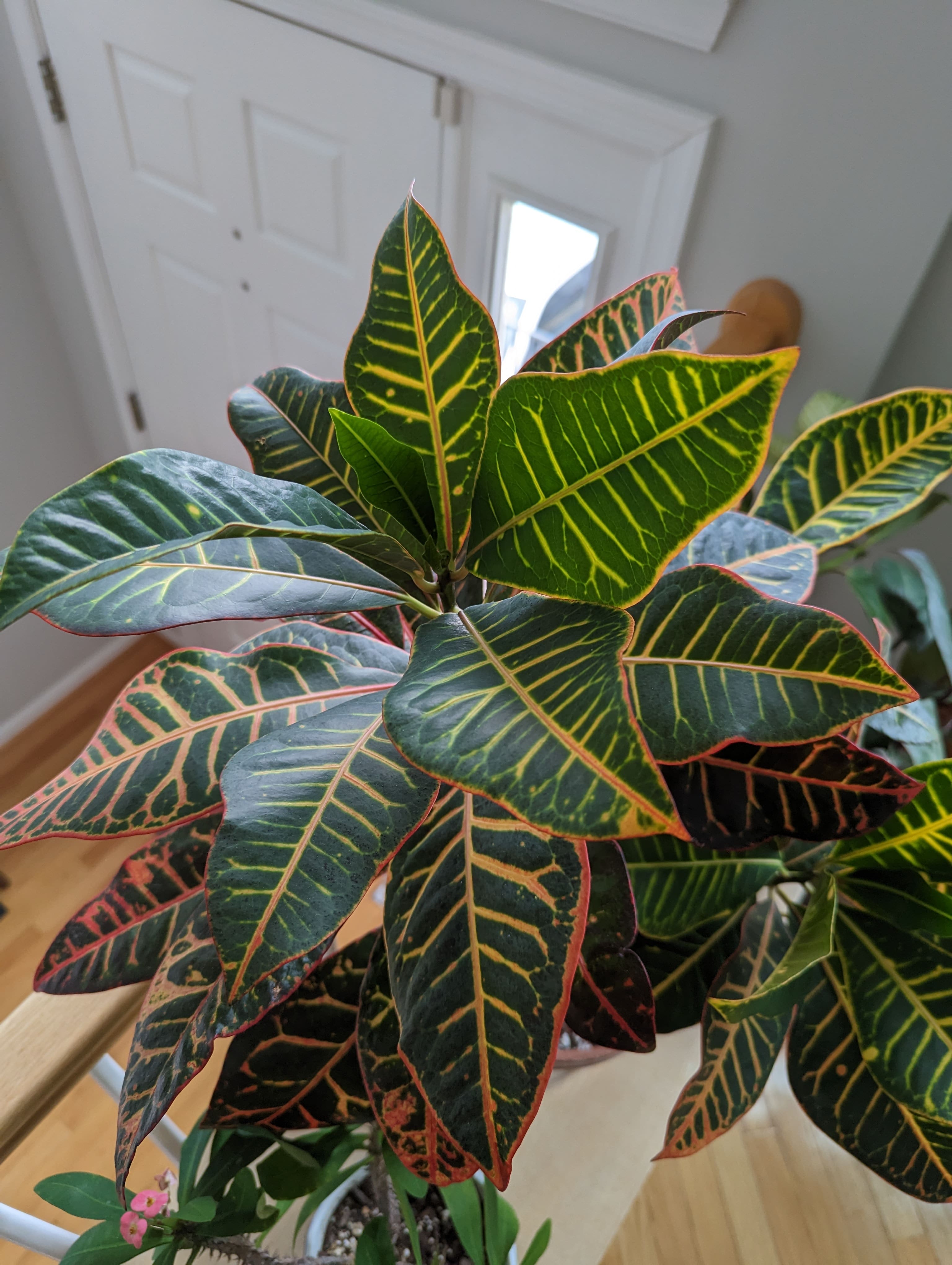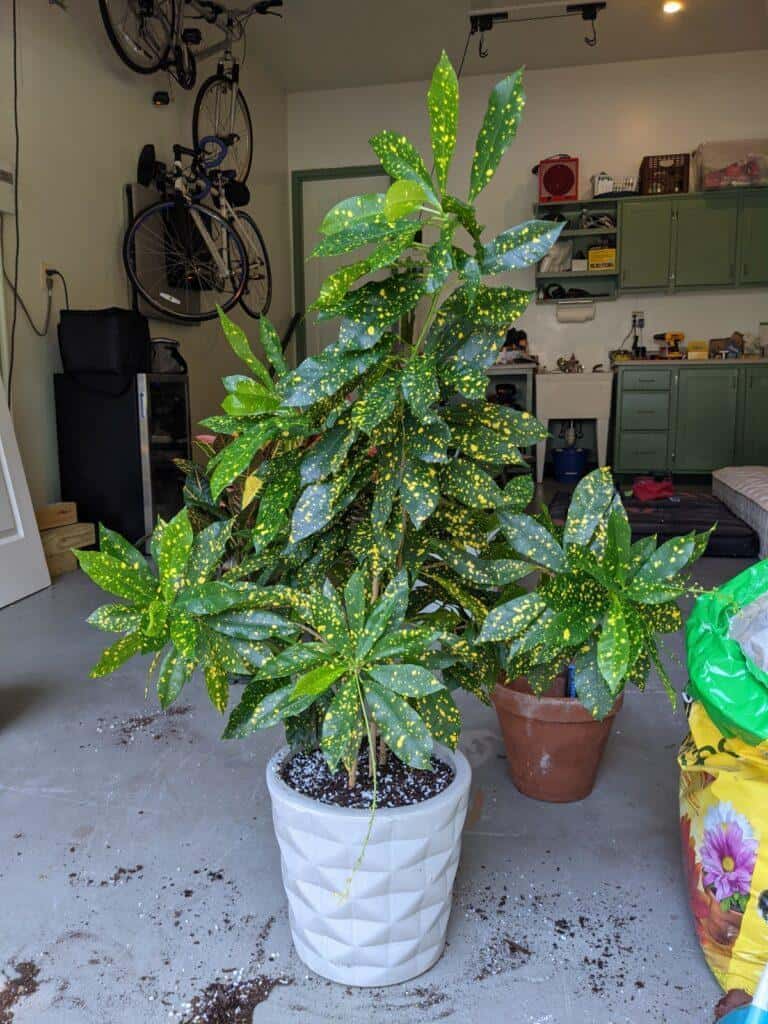Croton Plants are a plant enthusiasts’ favorite because of their striking foliage and vibrant colors. They sport a diverse array of leaf shapes and color patterns. With their color and variety, Crotons can add a splash of tropical flair to any space. In this post, I’ll delve into the common types of Croton leaves shapes. As a longtime Croton lover myself, I’ll address common leaf problems and offer solutions to help your Croton Plants thrive.
Common Croton Leaves
Each Croton variety has its own unique charm, making it an excellent choice for those looking to add a touch of diversity to their plant collection. Below are some of the most common Croton leaf types.
Oval Shaped Leaves
Oval shaped leaves are probably the most common shape, but they do come in various sizes. Crotons with larger oval leaves are Croton Petra, Magnificent Croton, and Mrs. Iceton. These larger oval leaves grow up to six to seven inches in length and bout two to three inches wide. A Croton with smaller oval shaped leaves is a Gold Dust Croton. Its leaves grow three to four inches in length and about one to two inches wide.

Long and Narrow Leaves
Crotons with slender leaves create a delicate and elegant appearance. In this category there are Crotons that have thin almost grass-like leaves such as the Zanzibar Croton. Crotons with long narrow leaves are Croton Golden Bell and Banana Croton. These Crotons sport leaves that are about four to five inches long and about one inch across. Their long narrow foliage showcases intricate patterns and bright colors.
Wavy Leaves
Some Croton varieties exhibit twisted or spiraled leaves, adding some texture to your garden. One of the most popular Crotons of this variety is the Mammy Croton. A harder to find variety is the Andrew Croton. Crotons with wavy leaves add a unique touch to your plant collection that is hard to get with any other plant.
Oakleaf Leaves
The Oakleaf Croton has colorful leaves that resemble the shape of an oak tree’s leaves. These leaves generally have three lobes and are about five inches long and around four inches across.
Croton Leaf Colors
As I mentioned earlier, part of Crotons popularity is due to their color nature. Some leaves sport colorful patterns that resemble paint splatter, or polka dots. Some have veins of varying color, while others have a large splotchy pattern.

It might be easier to list the colors that you don’t find on Crotons rather than the colors you do find. The most common colors on Croton leaves are green, yellow, cream, orange, red, purple and many shades in between.
Common Croton Leaf Problems and Solutions
The variety in color patterns make Crotons popular, but it can also make it difficult for plant owners to spot leaf problems early. Even the Croton leaf shape, such as the wavy varieties can make it hard to notice problems like leaf curling. Because of this, sometime Croton owners don’t spot issues right away. Here are some issues you might encounter and how to address them.
Leaf Browning or Yellowing
If your Croton’s leaves are browning or yellowing the first thing to look for is a water issue. Crotons like to have evenly moist soil and definitely don’t like to dry out all the way. Soil moisture meters are a cheap and accurate way to monitor your soil’s moisture easily.
Leaf Dropping
If your Croton is shedding leave, it may be due to a watering issue or insufficient light. Both over and underwatering can cause leaf drop. Check out my post on Croton watering to get in depth information on your Croton’s water needs. In terms of light, Crotons like bright indirect light.
Pests
Croton Plants can attract pests like aphids, mealybugs, and spider mites. It can be especially hard to notice damage from pests on Crotons because pests typically leave spotted or dappled yellow spots on the leaves, which easily blends into many Croton pattern. I have personally battled spider mites on my Crotons more than once. To rid you plant of pests you must remove the pests, treat with insecticide, monitor, and repeat. Follow my blog about spider mites on my Croton for step-by-step details.
Leaf Curling
Curling leaves may be a sign of inadequate humidity in Crotons. This could be lack of humidity, or moisture, in the soil or in the air. To increase soil moisture, just adjust your watering. You can increase humidity in the air by using a humidifier or placing a tray of water and pebbles nearby. One other possible cause for leaf curl is pests, so make sure you check your Croton thoroughly.
Crotons are an incredibly diverse group of plants. By understanding and addressing common leaf problems, you can ensure that your Croton Plant thrives. If you have any more Croton questions post them in the Comments section.

I'm a long time plant lover on the quest to happily coexist with as many plants as I can. Let's grow!
